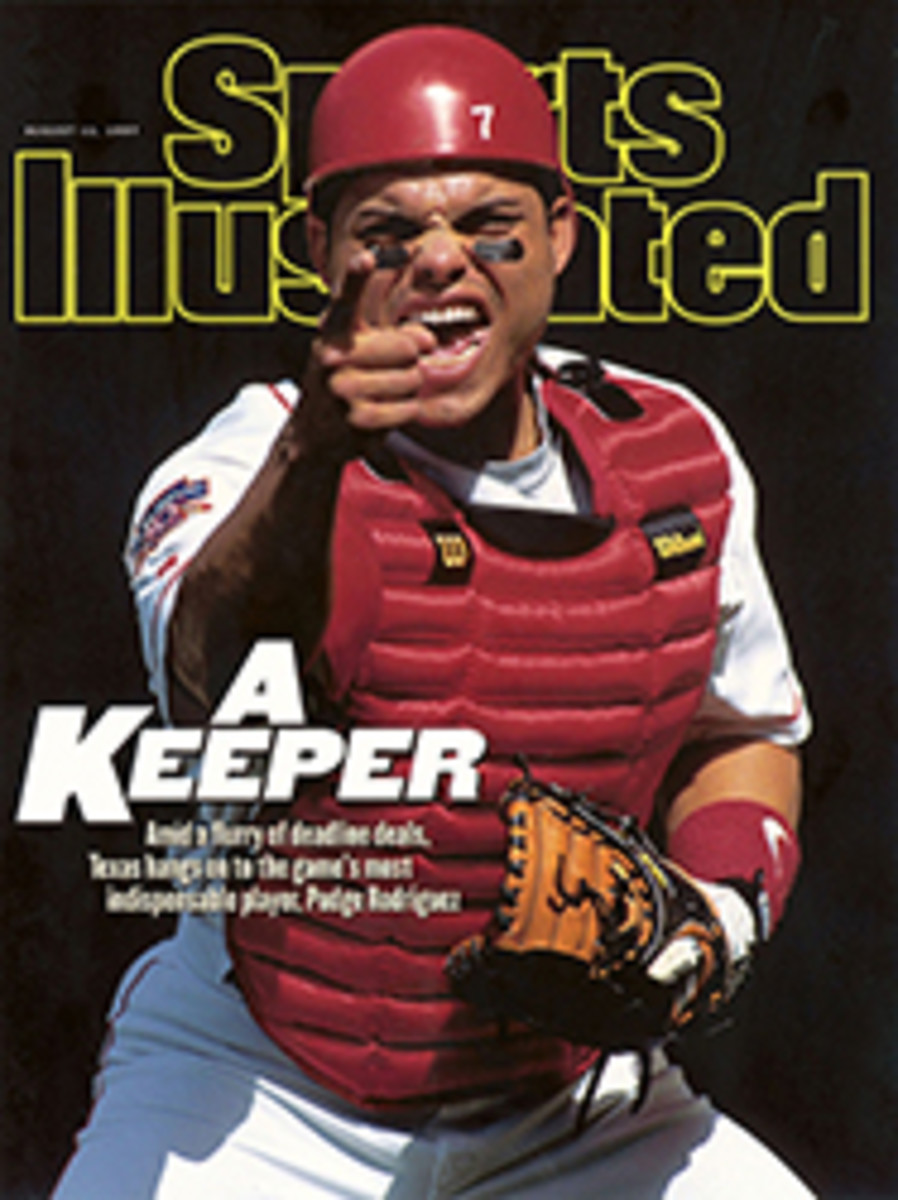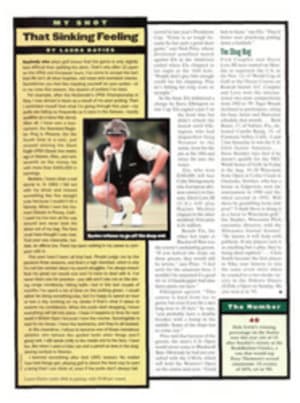
PURLOINED IN PARIS JOHNNY VAN RYN AND THE U.S. WOULD HAVE WON THE DAVIS CUP IN 1932 BUT FOR A BAD CALL
As one of sport's most coveted beauties, the Davis Cup, draws
closer to her 100th birthday, so too does an ardent suitor named
Johnny Van Ryn. Like a patient stage-door Johnny, Van Ryn waited
years for the leading lady of numerous tennis dramas to be his.
Oh, how close he came to embracing the Davis Cup in jubilant
conquest and sipping champagne from her sterling lips. She was
but 32 then, and--oo-la-la--they were in Paris.
"But," Van Ryn says 65 years later, his pale gray eyes dancing,
"the French stole the Cup from us. In broad daylight."
John William Van Ryn, who turned 92 on June 30, is five years
younger than the prize that eluded him and other U.S. Hall of
Famers such as Bill Tilden, Ellsworth Vines, Wilmer Allison and
George Lott for eight years. From 1929 through 1936, the U.S.
Davis Cup team reached the final four times. Now Van Ryn, the
lone survivor of those squads, sits beside the Atlantic Ocean in
Palm Beach, Fla., recalling the Great Cup Robbery of '32.
In 1927, the renowned Four Musketeers of France--Jean Borotra,
Rene Lacoste, Henri Cochet and Jacques Brugnon--broke the U.S.'s
seven-year stranglehold on the Davis Cup. They then launched
their own five-year reign of fuzzy-ball terror. "In those days,"
Van Ryn recalls, "there was a Challenge Round final. The team
that won the Cup had to play only once the following year, at
home, to defend it. That was a big advantage. The French had
built Stade Roland Garros in '28 specifically for the Challenge
Rounds, and they made sure those slow clay courts were even
slower-- watered 'em down like a swamp--when we Americans came
to town. But in '32 we figured we had 'em. The Crocodile, who
never beat himself, had retired." The Crocodile, of course, was
Lacoste, the toothy, cerebral engineer and inventor who was
known for keeping a book on every possible foe and would later
be known for designing and producing the first comfortable
short-sleeved cotton tennis shirt.
"We had the Number 1 guy in the world, Elly Vines, and, we
thought, the best doubles team, Allison and me," Van Ryn
continues. "But the first day was a disaster. Borotra upset
Vines, and Cochet beat Allison. We're down 2-0, and if Wilmer
and I don't win the doubles, it's all over."
Although Van Ryn twice ranked in the world's top 10 in singles
and owned a pair of wins over Tilden, his room and board in
those amateur days was doubles. Seemingly slight at 5'10" and
150 pounds, he was a discomfitting returner in the right-hand
court and a slick volleyer. He and Allison won 14 Cup matches, a
U.S. mark that has stood since 1936 and was tied in the 1980s by
the doubles team of John McEnroe and Peter Fleming. Van Ryn is
the only U.S. man to have won the Wimbledon doubles championship
three years running--once with Lott and twice with Allison. Van
Ryn and Allison also won the U.S. Doubles title in 1931 and '35
and were finalists six times between '30 and '36.
"So it was us or nothing that second day in Paris," Van Ryn
says. "The whole team felt Wilmer and I could start a comeback.
Mr. Davis [Dwight F. Davis, who donated the Cup and was
player-captain of the original U.S. side, in 1901] was very
encouraging. It was a battle. Five back-and-forth sets. The
French wanted to avoid a third-day showdown as much as we wanted
to force one, but we nosed out Cochet and Brugnon [6-3, 11-13,
7-5, 4-6, 6-4].
"When Wilmer and I won, everybody on our side felt great. We
were confident Vines could beat Cochet in his singles match, and
he did. Wilmer was sure he'd wrap it up against Borotra, which
he did--except they didn't let him win. They robbed him. And
us." Van Ryn shakes his well-groomed, thinly thatched head.
"Still unbelievable," he says, chuckling over what, in the
official record, stands as a victory for Borotra and France,
1-6, 3-6, 6-4, 6-2, 7-5.
Every seat, aisle and cranny of Roland Garros was filled for the
match. France's president, Albert Lebrun, sat in the first row,
and hundreds who couldn't get into the stadium stood outside and
cheered or pouted as scores were relayed to them.
"The place is pretty quiet as Wilmer wins the first two sets,"
Van Ryn says, drifting back over the decades. "But it turns into
a madhouse when Borotra wins the next two, and Borotra, the
showman in his beret, is urging 10,000 Frenchmen on. He's tired
and stalling, changes shoes three times during play when his
shoes come apart. But Wilmer shuts 'em up again by going up 5-3
in the fifth. He has some match points [three] but can't hold
serve. In the next game, though, he has another match point, at
ad out. Borotra's serving, nervous. He faults, into the net.
Then his second serve is way long. Clearly. Maybe a foot. It's
our match...but...but....
"As Wilmer and Borotra head for the net to shake hands, the
umpire calls, 'Egalite!' What did he say? Deuce! Not a peep from
the service linesman. So the serve that Wilmer hadn't tried to
return was considered good, Borotra's point. Incredible! The
match goes on, and Wilmer loses. We don't win the Cup because of
the linesman, a great patriot--and grand larcenist."
Even reports in some French newspapers confirmed Van Ryn's
testimony that the serve was a fault. Al Laney, a respected
writer for the New York Herald Tribune, observed, "The U.S. has
won the Cup but the trophy remains in France. Perhaps the mute
linesman, Gerard de Ferrier, has a hero's spot in the Pantheon."
Van Ryn was sitting next to Dwight Davis. "He was a great
gentleman," Van Ryn says. "He was livid. I'd never heard him
curse, but that day he said, 'I'm goddam sorry I ever gave the
Cup,' and withdrew us from the traditional teams dinner that
night as his protest."
In 1937 Don Budge, Frank Parker, Gene Mako and Bitsy Grant ended
the longest U.S. Davis Cup drought, beating Great Britain in the
windup. "I was through by then, had to go to work steady," Van
Ryn says. "But I'd made good contacts. Charlie Merrill [a
founder of Merrill Lynch] called me and asked me to open a new
office in Palm Beach, and I've been here since."
Van Ryn's only rival now is a backboard at The Everglades Club
against which he hits balls 45 minutes a day. He also strokes at
an easel, having taken up painting in 1990.
"When I played, there was no money in the game like Sampras and
the boys make today," he says without envy. Davis Cup team
members got something like three dollars a day for
expenses--somewhat less than the $50,000 to $100,000 per Cup
weekend that today's players command. "But there were perks,"
Van Ryn says. "My first captain was Fitz-Eugene Dixon, a
Philadelphia millionaire. His wife was Eleanor Widener--you
know, the Widener Library at Harvard?--so we stayed in the best
places. One time in Paris we were going to a formal dinner.
Wilmer and I didn't have evening clothes, but Mrs. Dixon saw to
that. Then she says, 'What about links and studs?' So she takes
us to Cartier, and they bring out diamonds and rubies. 'Take
your pick,' she says. Wilmer took diamonds, I took rubies, and
she ordered them made into links and studs set in platinum. [Van
Ryn had the set made into a necklace for his wife of 50 years,
Cornelia.] Mr. Dixon told Wilmer and me he'd give us cars if we
repeated at Wimbledon in '30. And there it was, on the dock, my
red Ford, when the boat landed in New York.
"We didn't have any money," says the elder strokesman of the
International Tennis Hall of Fame, in Newport, R.I., and the
oldest living former Davis Cupper. "I went through Princeton on
an athletic scholarship. But, at times, tennis was as good as
being rich."
NBC tennis commentator Bud Collins entered the International
Tennis Hall of Fame in 1994.
COLOR PHOTO: BRIAN SMITH Van Ryn, 92, who still strikes the fuzzy ball 45 minutes a day, says tennis was "as good as being rich." [Johnny Van Ryn with tennis rackets and trophy]
B/W PHOTO: FPG INTERNATIONAL Allison and Van Ryn (from left) beat Germany's Daniel Prenn and Hans Moldenhauer (far right) in 1929, one of their 14 Davis Cup wins. [Wilmer Allison, Johnny Van Ryn, Daniel Prenn and Hans Moldenhauer]

